By Pauline Weston Thomas for Fashion-Era.com

Queen Elizabeth I Costume 1558-1603 by Dion Clayton Calthrop
- A MAN OF THE TIME OF ELIZABETH - 1558-1603
- A WOMAN OF THE TIME OF ELIZABETH - 1558-1603
- WOMAN OF THE TIME OF ELIZABETH - 1558-1603
- SHAKESPEARE AND CLOTHES
This Tudor costume history information consists of Pages 291-324 of the chapter on the mid to late 16th century dress in the 45 YEAR REIGN era of Elizabeth The First 1558-1603, and taken from English Costume by Dion Clayton Calthrop.
The 36 page section consists of a text copy of the book ENGLISH COSTUME PAINTED & DESCRIBED BY DION CLAYTON CALTHROP. Visuals, drawings and painted fashion plates in the book have a charm of their own and are shown amid the text. The book covers both male and female dress history of over 700 years spanning the era 1066-1830.
This page is about dress in the reign of Queen Elizabeth I Tudor 1558-1603.
For the Introduction to this book see this introduction written by Dion Clayton Calthrop. I have adjusted the images so they can be used for colouring worksheets where pupils add some costume/society facts.
My comments are in italics.
Queen Elizabeth I Costume - 1558-1603 Reigned 45 years.
THE MEN
An Age of New Discoveries
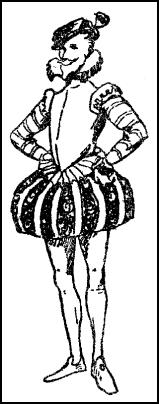 Here we are in the middle of great discoveries with adventurers, with Calvin and Michael Angelo, living and dying, and Galileo and Shakespeare seeing light - in the very centre and heart of these things, and we and they discussing the relations of the law to linen. How, they and we ask, are breeches, and slop-hose cut in panes, to be lined? In such writings we are bound to concern ourselves with the little things that matter, and in this reign we meet a hundred little things, little fussy things, the like of which we leave alone to-day. But this is not quite true. To-day a man, whether he cares to admit it or no, is for ever choosing patterns, colours, shades, styles to suit his own peculiar personality. From the cradle to the grave we are decked with useless ornaments - bibs, sashes, frills, little jackets, neat ties, different coloured boots, clothes of ceremony, clothes supposed to be in harmony with the country, down, at last, to the clothes of an old gentleman, keeping a vague reminder of twenty, thirty years ago in their style, and then - grave clothes.
Here we are in the middle of great discoveries with adventurers, with Calvin and Michael Angelo, living and dying, and Galileo and Shakespeare seeing light - in the very centre and heart of these things, and we and they discussing the relations of the law to linen. How, they and we ask, are breeches, and slop-hose cut in panes, to be lined? In such writings we are bound to concern ourselves with the little things that matter, and in this reign we meet a hundred little things, little fussy things, the like of which we leave alone to-day. But this is not quite true. To-day a man, whether he cares to admit it or no, is for ever choosing patterns, colours, shades, styles to suit his own peculiar personality. From the cradle to the grave we are decked with useless ornaments - bibs, sashes, frills, little jackets, neat ties, different coloured boots, clothes of ceremony, clothes supposed to be in harmony with the country, down, at last, to the clothes of an old gentleman, keeping a vague reminder of twenty, thirty years ago in their style, and then - grave clothes.
How well we know the Elizabethan! He is a stock figure in our imagination; he figured in our first schoolboy romances, he strutted in the first plays we saw. Because it was an heroic time we hark back to it to visualize it as best we may so that we can come nearer to our heroes - Drake, Raleigh, and the rest. The very names of the garments arouse associations - ruff, trunks, jumper, doublet, jerkin, cloak, bone-bobbin lace, and lace of Flanders - they almost take one's breath away.
Here comes a gentleman in a great ruff, yellow-starched, an egg-shaped pearl dangles from one ear. One hand rests on his padded hip, the other holds a case of toothpicks and a napkin; he is going to his tavern to dine. His doublet is bellied like a pea's cod, and his breeches are bombasted, his little hat is stuck on one side and the feather in it curls over the brim. His doublet is covered with a herring-bone pattern in silk stitches, and is slashed all over. He is exaggerated, monstrous; he is tight-laced; his trunks stick out a foot all round him, and his walk is, in consequence, a little affected; but, for all that, he is a gallant figure.
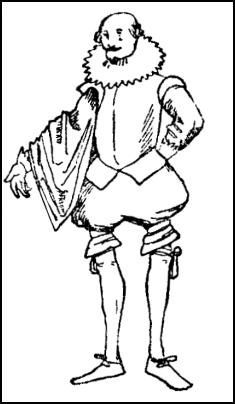 Behind him comes a gentleman in loose knee-breeches barred with velvet; at the knee he has a frill of lace. His jerkin is not stuffed out, and his ruff is not starched to stick up round his head. His hair is cut in three points, one over each ear and the third over the centre of his forehead, where we see a twisted lock tied with ribbon.
Behind him comes a gentleman in loose knee-breeches barred with velvet; at the knee he has a frill of lace. His jerkin is not stuffed out, and his ruff is not starched to stick up round his head. His hair is cut in three points, one over each ear and the third over the centre of his forehead, where we see a twisted lock tied with ribbon.
We seem to know these people well - very well.
The first, whose clothes are of white silk sewn with red and blue, whose trunk hose have clocks of silk sewn on them, reminds us of whom? And the second gentleman in green and red, with heels of red on his shoes? Suddenly there flashes across our memory the picture of a lighted stage, a row of shops, a policeman, and then a well-known voice calling, 'Hello, Joey, here we are again!'
Here we are again after all these centuries - clown and pantaloon, the rustic with red health on his face, the old man in Venetian slops - St. Pantaloone - just as Elizabethan, humour included, as anything can well be.
The Harlequin
Then, enter Harlequin in his clothes of gorgeous patches; the quick, almost invisible thief, the instigator of all the evil and magic. His patches and rags have grown to symmetrical pattern, his loose doublet has become this tight-fitting lizard skin of flashing gold and colours, but his atmosphere recalls the great days.
To these enter 1830 - Columbine - an early Victorian lady, who contrives to look sweetly modest in the shortest and frilliest of skirts; she looks like a rose, a rose on two pink stalks. She, being so different, gives the picture just the air of magic incongruity. Once, years ago, she was dressed in rags like Harlequin, but I suppose that the age of sentiment clothed her in her ballet costume rather than see her in her costly tatters.
Punch, Judy & Toby
We are a conservative nation, and we like our own old jokes so much that we have kept through the ages this extraordinary pleasing entertainment straight down, clothes and all, from the days of Queen Elizabeth.
Even as we dream of this, and the harlequinade dazzles our eyes, the dream changes - a new sound is heard, a sound from the remote past, too. We listen eagerly, clown, pantaloon, harlequin, and columbine vanish to the sound of the pan-pipes and the voice of Punch.
'Root-ti-toot, rootity-toot!' There, by the corner of the quiet square, is a tall box covered with checkered cloth. Above a man's height is an opening, and on a tiny stage are two figures, one in a doublet stiffened out like a pea pod, with a ruff hanging loose about his neck, bands at his wrists, a cap on his head - Punch.
The other with a linen cap and a ruff round her neck - Judy.
Below, on the ground by the gentleman who bangs a drum and blows on the pan-pipes stuck in his muffler, is a dog with a ruff round his neck - Toby.
And we know - delightful to think of it - that a box hidden by the check covering, contains many curiously dressed figures - all friends of ours. The world is certainly curious, and I suppose that an Elizabethan revisiting us to-day would find but one thing the same, the humour of the harlequinade and the Punch and Judy show.
Calthrop's Suggestions for Books Which Allude to Costume Details & Manners
Now let us get to the dull part. If you wish to swim in a sea of allusions there are a number of books into which you may dive -
- 'Microcynicon.'
- 'Pleasant Quippes for Upstart Newfangled Gentlewomen.'
- Hall's 'Satires.'
- Stubbes' 'Anatomie of Abuses.'
- 'The Cobbler's Prophesie.'
- 'The Debate between Pride and Lowliness.'
.jpg)
- 'The Letting of Humours Blood in the Head Vaine.'
- 'The Wits Nurserie.'
- Euphues' 'Golden Legacie.'
- 'Every Man out of his Humour.'
If you do not come out from these saturated with detail then you will never absorb anything.
A MAN OF THE TIME OF ELIZABETH - 1558-1603
In this Elizathethan fashion plate the gentleman wears a double linen collar, as common at this time in history as the ruff. You can see his trunk hose through the openings of his trunks. Two leather straps hold up his boots. His flourish is the Italian fashion cloak.
Dress of Shakespeare's Era
The Doublet
For the shapes, the doublet was a close-fitting garment, cut, if in the Italian fashion, down to a long peak in front. They were made without sleeves, like a waistcoat, and an epaulette overhung the armhole.
The sleeves were tied into the doublet by means of points (ribbons with metal tags).
Pea's Cod Bellied Doublet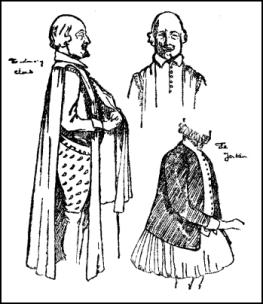
These doublets were for a long time stuffed or bombasted into the form known as 'pea's cod bellied' or 'shotten-bellied.'
The Jerkin
The jerkin was a jacket with sleeves, and was often worn over the doublet. The sleeves of the jerkin were often open from shoulder to wrist to show the doublet sleeve underneath. These sleeves were very wide, and were ornamented with large buttons.
The Jornet
The jornet was a loose travelling cloak in Elizabethan times.
The Jumper
The jumper a loose jerkin, worn for comfort or extra clothing in winter. Both doublet and jerkin had a little skirt or base.
Trunks, Breeches, Hose
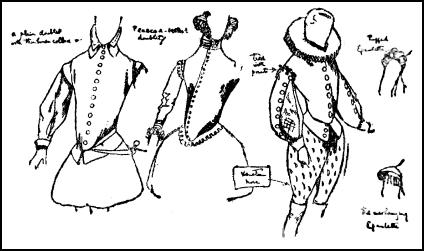 The very wide breeches known as trunks were worn by nearly everybody in the early part of the reign, until they vied with Venetian breeches for fashion.
The very wide breeches known as trunks were worn by nearly everybody in the early part of the reign, until they vied with Venetian breeches for fashion.
They were sometimes made of a series of wide bands of different colours placed alternately; sometimes they were of bands, showing the stuffed trunk hose underneath.
They were stuffed with anything that came handy - wool, rags, or bran - and were of such proportions that special seats were put in the Houses of Parliament for the gentlemen who wore them.
The fashion at its height appears to have lasted about eight years.
Right - Trunks.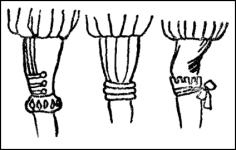
Venetian Breeches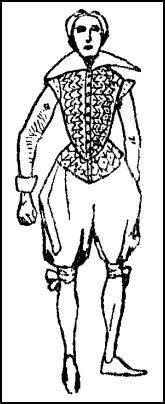
The Venetian breeches were very full at the top and narrowed to the knee; they were slashed and puffed, or paned like lattice windows with bars of coloured stuffs or gold lace.
French Breeches
The French breeches were tight and ruffled in puffs about the thighs.
Stockings
The stockings were of yarn, or silk, or wool. They were gartered about the knee, and pulled up over the breeches; but the man most proud of his leg wore no garters, but depended on the shape of his leg and the fit of his stocking to keep the position.
These stockings were sewn with clocks at the ankles, and had various patterns on them, sometimes of gold or silver thread. Openwork stockings were known.
§
Trunk Hose & Trunks
The stockings and breeches were called, if the breeches were short and the stockings all the way up the leg, trunk hose and trunks; if the breeches came to the knee and the stockings just came over them, they were known as upper stocks and nether stocks.
Footwear
The shoes were shaped to the foot, and made of various leathers or stuffs; a rose of ribbon sometimes decorated the shoes. 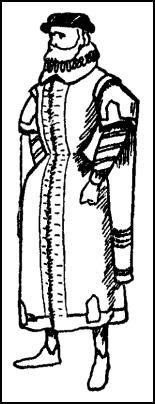 There were shoes with high cork soles called moyles. Of course, there were gallants who did things no one else thought of doing - wearing very square-toed shoes, for instance, or cock feathers in their hair.
There were shoes with high cork soles called moyles. Of course, there were gallants who did things no one else thought of doing - wearing very square-toed shoes, for instance, or cock feathers in their hair.
The sturtops were boots to the ankle.
Mens Hair - Love-Lock
As for the hair, we have the love-lock tied with ribbons, the very same that we see caricatured in the wigs of clown and pantaloon. We have, also, hair left fairly long and brushed straight back from the forehead, and short-cropped hair. Beards and moustaches are worn by most.
Little Cloaks
They wore little cloaks covered with embroidery, lace, sometimes even with pearls. For winter or for hard travelling the jornet or loose cloak was worn.
Elderly Dress
The older and more sedate wore long stuff gowns with hanging sleeves; these gowns, made to fit at the waist and over the trunks, gave an absurd Noah's ark-like appearance to the wearers. Those who cared nothing for the fashions left their gowns open and wore them loose.
The Clothes of Common People in Elizabethan Era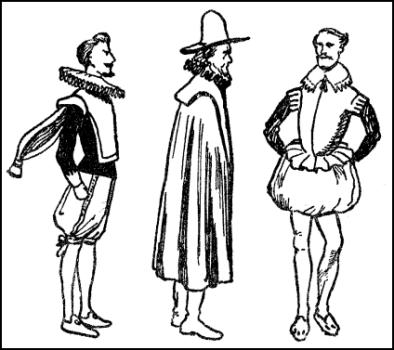
The common people wore simple clothes of the same cut as their lords - trunks or loose trousers, long hose, and plain jerkins or doublets. In the country the fashions alter, as a rule, but little; however, in this reign Corydon goes to meet Sylvia in somewhat fashionable clothes.
Lodge says: 'His holiday suit marvellous seemly, in a russet jacket, welted with the same, and faced with red worsted, having a pair of blue camblet sleeves, bound at the wrists with four yellow laces, closed before very richly with a dozen pewter buttons. His hose of gray kersey, with a large slop barred all across the pocket holes with three fair guards, stitched on either side with red thread.'
His stockings are also gray kersey, tied with different coloured laces; his bonnet is green, and has a copper brooch with the picture of St. Dennis. 'And to want nothing that might make him amorous in his old days, he had a fair shirt-band of white lockeram, whipt over with Coventry blue of no small cost.'
Men's Hats
The hats worn vary in shape from steeple-crowned, narrow-brimmed hats, to flat, broad-crowned hats; others show the coming tendency towards the broad-brimmed Jacobean hat. Round these hats were hatbands of every sort, gold chains, ruffled lace, silk or wool.
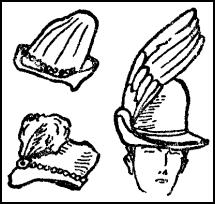
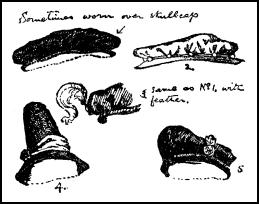
I think we may let these gallants rest now to walk among the shades - a walking geography of clothes they are, with French doublets, German hose, Spanish hats and cloaks, Italian ruffs, Flemish shoes; and these with chalked faces, fuzzed periwigs of false hair, partlet strips, wood busks to keep straight slim waists, will make the shades laugh perhaps, or perhaps only sigh, for there are many in that dim wardrobe of fashions who are still more foolish, still more false, than these Elizabethans.
ELIZABETH I COSTUME - 1558-1603
THE WOMEN
Hoops & Hair
Now this is the reign of the ruff and the monstrous hoop and the wired hair. As a companion to her lord, who came from the hands of his barber with his hair after the Italian manner, short and round and curled in front and frizzed, or like a Spaniard, long hair at his ears curled at the two ends, or with a French love-lock dangling down his shoulders, she - his lady - sits under the hands of her maid, and tries various attires of false hair, principally of a yellow colour.
Every now and again she consults the looking-glass hanging on her girdle; sometimes she dresses her hair with chains of gold, from which jewels or gold-work tassels hang; sometimes she, too, allows a love-lock to rest upon her shoulder, or fall negligently on her ruff.
Even the country girl eagerly waits for news of the town fashions, and follows them as best she may.
In the early part of the reign the simple costume of the previous reign was still worn, and even the court ladies were quietly, though richly, dressed.
The Ruff
In the first two years the ruff remained a fairly small size, and was made of holland, which remained stiff, and held the folds well; but later, there entered several Dutch ladies, headed by Mistress Dingham Vander Plasse, of Flanders, in 1564, who taught her pupils the art of starching cambric, and the art of folding, cutting, and pinching ruffs at five pounds a head, and the art of making starch, at the price of one pound.
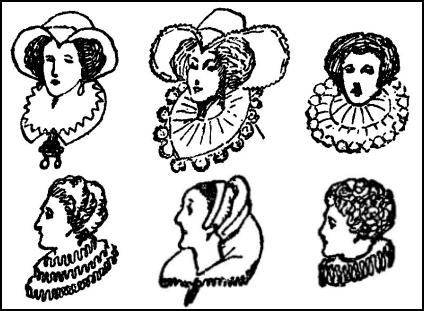
Underproper of Wire and Holland
First, the lady put on her underproper of wire and holland, and then she would place with a great nicety her ruff of lace, or linen, or cambric. One must understand that the ruff may be great or small, that only the very fashionable wore such a ruff as required an underproper, and that the starched circular ruff would stand by itself without the other appliance.
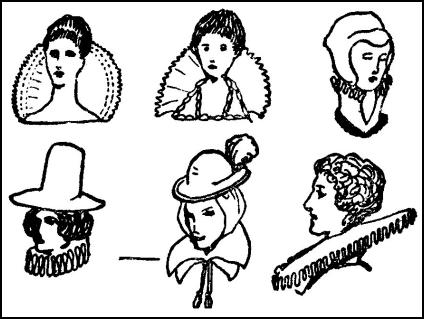
The Typical Costume For Early Elizabethan Lady
Before the advent of the heavily-jewelled and embroidered stomacher, and the enormous spread of skirt, the dress was a modification of that worn by the ladies in the time of Henry VIII.
First, a gown cut square across the bosom and low over the shoulders, full sleeves ending in bands of cambric over the hands (these sleeves slit to show puffs of cambric from the elbow to the wrist), the skirt full and long, but without any train; the whole fitted well to the figure as far as the waist, and very stiff in front.
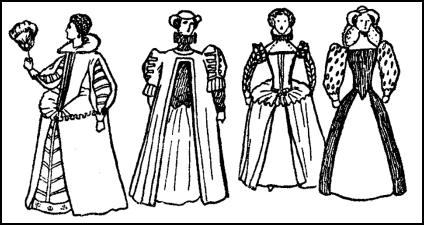
Over this a second gown, generally of plain material, split above in a V-shape, split below at the waist, and cut away to show the under-gown. The sleeves of this gown were wide, and were turned back or cut away just by the elbow.
Elizabethan Lacing
Both gowns were laced up the back. This second gown had, as a rule, a high, standing collar, which was lined with some rich silk or with lace.
A WOMAN OF THE TIME OF ELIZABETH - 1558-1603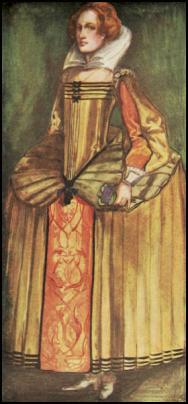
This shape gave way to a more exaggerated form, and finally to many varieties of exaggeration.
The Ladies Jerkin
The lady might wear a jerkin like in shape to a man's, except that often it was cut low and square over the bosom, and was not stuffed quite so much in front; every variety of rich material was used for this jerkin, and the sleeves were as varied as were the man's, split and tied with ribbons.
Women's False Sleeves
False sleeves attached at the shoulders, and left to hang loose, puffed, slashed all over, with or without bands of cambric or lace at the wrists; these bands sometimes were frills, sometimes stiffened and turned back. No person except royalty might wear crimson except in under-garments, and the middle class were not allowed to wear velvet except for sleeves.
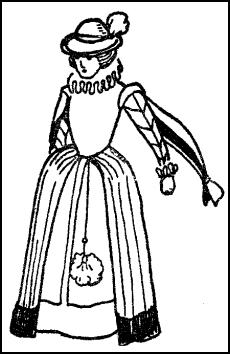 This jerkin was sometimes worn buttoned up, like a man's, to the neck, and when the hoops came into fashion and were worn high up near the waist, the basque or flounce at the bottom of the jerkin was made long, and pleated full to the top of the hooped petticoat.
This jerkin was sometimes worn buttoned up, like a man's, to the neck, and when the hoops came into fashion and were worn high up near the waist, the basque or flounce at the bottom of the jerkin was made long, and pleated full to the top of the hooped petticoat.
The plainer fashion of this was a gown buttoned high - up to the ruff - and opened from the waist to the feet to show a full petticoat of rich material; this was the general wear of the more sober-minded.
The Cape
Sometimes a cape was worn over the head and shoulders, not a shaped cape, but a plain, oblong piece of stuff. The ladies sometimes wore the shaped cape, with the high collar that the men wore.
The French hood with a short liripipe was worn by country ladies; this covered the hair, showing nothing but a neat parting in front.
Openwork Lace Bonnet
The openwork lace bonnet, of the shape so well known by the portraits of Queen Mary of Scotland, is not possible to exactly describe in writing; one variety of it may be seen in the line drawing given. It is made of cambric and cut lace sewn on to wires bent into the shape required.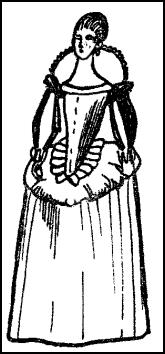
In such a time of extravagance in fashion the additions one may make to any form of dress in the way of ribbons, bows, sewn pearls, cuts, slashes, and puffs are without number, and I can only give the structure on which such ornamental fripperies can be placed.
Elizabethan Women's Hair Accessories
The hair, for example, can be dressed with pearls, rings of gold, strings of pearls, feathers, or glass ornaments. Men and women wore monstrous earrings, but curiously enough this fashion was more common to men than women.
Ladies Hats
Hats were interchangeable, more especially the trim hat with a feather, in shape like those worn by the Yeoman of the Guard, but smaller.
The shoulder pinions of the jerkins were puffed, slashed, and beribboned in every way.
The wing sleeves, open from the shoulder all the way down, were so long sometimes as to reach the ground, and were left hanging in front, or thrown back over the shoulders, the better to display the rich under-sleeve.
Ladies Shoes
The ladies' shoes were cork-soled, high-heeled, and round-toed.
Girdles
The girdles were of every stuff, from gold cord, curiously knotted, to twisted silk; from these hung looking-glasses, and in them were stuck the embroidered and scented gloves.
Masked Ladies
Ladies went masked about the streets and in the theatres, or if they wished to be unconventional, they sat in the playing booths unmasked, their painted faces exposed to the public gaze.
Shoes - Chopines
The shoes with the high cork soles, to which I have just alluded, were in common use all over Europe, and were of all heights - from two inches to seven or eight - and they were called chopines. They were not such a foolish custom as might appear, for they protected the wearer from the appalling filth of the streets.
The tall chopines that Hamlet mentions were really very high-soled slippers, into which the richly-embroidered shoes were placed to protect them when the ladies walked abroad. The shoes were made of leather and velvet stitched with silk, embroidered with gold, or stamped with patterns, slashed sometimes, and sometimes laced with coloured silk laces.
Fine Materials - Lace, Bombazine & Silk in Elizabethan Costume
Some ladies wore bombazines, or a silk and cotton stuff made at Norwich, and bone lace made at Honiton, both at that time the newest of English goods, although before made in Flanders; and they imported Italian lace and Venetian shoes, stuffed their stomachers with bombast, and wore a frontlet on their French hoods, called a bongrace, to keep their faces from sunburn.
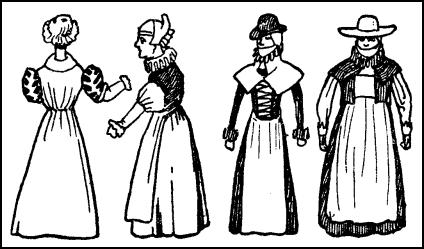
Cambric & Calico
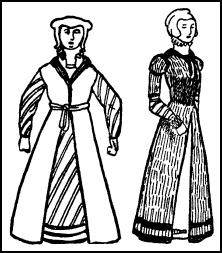 Cambric they brought from Cambrai in France, and calico from Calicut in India - the world was hunted high and low for spoil to deck these gorgeous, stiff, buckramed people, so that under all this load of universal goods one might hardly hope to find more than a clothes prop; in fact, one might more easily imagine the overdressed figure to be a marvellous marionette than a decent Englishwoman.
Cambric they brought from Cambrai in France, and calico from Calicut in India - the world was hunted high and low for spoil to deck these gorgeous, stiff, buckramed people, so that under all this load of universal goods one might hardly hope to find more than a clothes prop; in fact, one might more easily imagine the overdressed figure to be a marvellous marionette than a decent Englishwoman.
Falstaff will not wear coarse dowlas shirts, dandies call for ostrich feathers, ladies must have Coventry blue gowns and Italian flag-shaped fans; everybody is in the fashion from milkmaids to ladies of the court, each as best as they may manage it.
The Jew moves about the streets in his long gaberdine and yellow cap, the lady pads about her garden in tall chopines, and the gentleman sits down as well as he may in his bombasted breeches and smokes Herbe de la Reine in a pipe of clay, and the country woman walks along in her stamell red petticoat guarded or strapped with black, or rides past to market in her over-guard skirts.
The Queen In Her Bedchamber
Let us imagine, by way of a picture of the times, the Queen in her bedchamber under the hands of her tiring-women:
She is sitting before a mirror in her embroidered chemise of fine Raynes linen, in her under-linen petticoat and her silk stockings with the gold thread clocks. Over these she wears a rich wrap. Slippers are on her feet.
In front of her, on a table, are rouge and chalk and a pad of cotton-wool - already she has made up her face, and her bright bird-like eyes shine in a painted mask, her strong face, her hawk-like nose and her expressionless mouth reflect back at her from the mirror.
Beside the rouge pot is a Nuremberg egg watch, quietly ticking in its crystal case.
One of the women brings forward a number of attires of false hair, golden and red, and from these the Queen chooses one. It is a close periwig of tight red curls, among which pearls and pieces of burnished metal shine. With great care this wig is fastened on to the Queen's head, and she watches the process with her bright eyes and still features in the great mirror.
Then, when this wig is fixed to her mind, she rises, and is helped into the privie coat of bones and buckram, which is laced tightly by the women at her back. Now comes the moment when they are about to fasten on her whalebone hips the great farthingale - over which her voluminous petticoats and skirts will fall.
The wheel of bone is tied with ribbons about her waist, and there securely fastened.
After some delay in choosing an under-gown, she then puts on several linen petticoats, one over another, to give the required fulness to her figure; and then comes the stiffly-embroidered under-gown - in this case but a petticoat with a linen bodice which has no sleeves.
A WOMAN OF THE TIME OF ELIZABETH TUDOR - 1558-1603
Compare this with the other fashion plate showing the opposite fashion.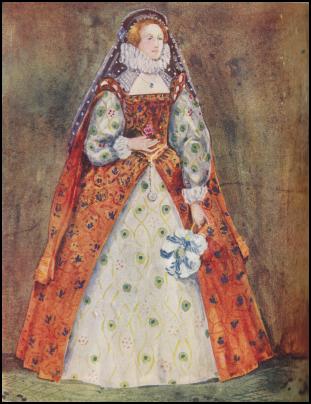

With great care she seats herself on a broad chair, and a perfect army of ruffs is laid before her. As the tire-woman is displaying the ruffs she talks to the Queen, and tells her that peculiar story, then current, of the Lady of Antwerp, who was in a great way because she could not get her ruff to set aright, and when in a passion she called upon the devil to take it, as if in answer to the summons a young and handsome gentleman appeared. Together they tried the ruff, and the young gentleman suddenly strangled the lady and vanished. Now when they came to carry away the coffin of the lady some days later, it was found that no one could lift it, so, in the end, it was opened, and there, to the surprise of everybody, sat a great black cat setting a ruff.
The Queen's eyes twinkle on this story, for she has a great fund of dry humour - and so, to the business of the ruffs. First one and then another is discarded; and finally the choice falls between one of great size, shaped like a catherine-wheel and starched blue, and the other of three depths but not of such great circumference, starched yellow, after the receipt of Mrs. Turner, afterwards hung at Tyburn in a ruff of the same colour.
The Queen wavers, and the tire-woman recommends the smaller bands: 'This, madame, is one of those ruffs made by Mr. Higgins, the tailor near to St. James's, where he has set up an establishment for the making of such affairs - it is a picadillie, and would '
Dressing - Queen Elizabeth I Costume
The Queen stops her and chooses the ruff; it is very much purled into folds, and it bristles with points.
Mahoitres
The women approach with a crimson over-gown and slips it over the Queen's head - it is open in front to show the rich petticoat, and it has great stuffed wings, epaulettes, or mahoitres on the shoulders.
Virago Sleeves
The tight-fitting bodice of the gown is buttoned up to the throat, and is stuffed out in front to meet the fall of the hoops; it has falling sleeves, but the real sleeves are now brought and tied to the points attached to the shoulders of the gown. They are puffed sleeves of the same material as the under-gown, and the falling sleeves of the upper gown are now tied with one or two bows across them so that the effect of the sleeves is much the same as the effect of the skirts; an embroidered stuff showing in the opening of a plain material. These are called virago sleeves.
Underproper, Supportasse, Picadillie Ruff & Muckinder
This done, the strings of pearls are placed around the Queen's neck, and then the underproper or supportasse of wire and holland is fastened on her neck, and the picadillie ruff laid over it. The Queen exchanges her slippers for cork-soled shoes, stands while her girdle is knotted, sees that the looking-glass, fan, and pomander are hung upon it, and then, after a final survey of herself in the glass, she calls for her muckinder or handkerchief, and - Queen Elizabeth is dressed.
Piccadilly Naming
So in this manner the Queen struts down to posterity, a wonderful woman in ridiculous clothes, and in her train we may dimly see Mr. Higgins, the tailor, who named a street without knowing it, a street known in every part of the civilized world; but, nowadays, one hardly thinks of connecting Piccadilly with a lace ruff....
SHAKESPEARE AND CLOTHES
There are not so many allusions to Elizabethan dress in the plays of Shakespeare as one might suppose upon first thought. One has grown so accustomed to Shakespeare put on the stage in elaborate dresses that one imagines, or one is apt to imagine, that there is a warrant for some of the dresses in the plays. In some cases he confounds the producer and the illustrator by introducing garments of his own date into historical plays, as, for example, Coriolanus. Here are the clothes allusions in that play:
'When you cast your stinking greasy caps,
You have made good work,
You and your apron-men.'
'Go to them with this bonnet in your hand.'
'Enter Coriolanus in a gown of humility.'
'Matrons fling gloves, ladies and maids their scarfs and handkerchers.'
'The kitchen malkin pins her richest lockram (coarse linen) 'bout her reechy neck.'
'Our veiled dames.'
'Commit the war of white and damask in their nicely gawded cheeks to the wanton and spoil of Phœbus' burning kisses.'
'Doublets that hangmen would bury with these that wore them.'
I have not kept the lines in verse, but in a convenient way to show their allusions.
In 'Pericles' we have mention of ruffs and bases.
Pericles says:
'I am provided of a pair of bases.'
Certainly the bases might be made to appear Roman, if one accepts the long slips of cloth or leather in Roman military dress as being bases; but Shakespeare is really - as in the case of the ruffs - alluding to the petticoats of the doublet of his time worn by grave persons. Bases also apply to silk hose.
In 'Titus Andronicus' we have:
'An idiot holds his bauble for his God.'
Julius Cæsar is mentioned as an Elizabethan:
'He plucked ope his doublet.'
The Carpenter in 'Julius Cæsar' is asked:
'Where is thy leather apron and thy rule?'
The mob have 'sweaty night-caps.'
Cleopatra, in 'Antony and Cleopatra,' says:
'I'll give thee an armour all of gold.'
The 'Winter's Tale,' the action of which occurs in Pagan times, is full of anachronisms. As, for instance, Whitsun pastorals, Christian burial, an Emperor of Russia, and an Italian fifteenth-century painter.
Also:
'Lawn as white as driven snow;
Cyprus (thin stuff for women's veils) black as ere was crow;
Gloves as sweet as damask roses;
Masks for faces and for noses;
Bugle-bracelet, necklace amber,
Perfume for a lady's chamber;
Golden quoifs and stomachers,
Pins and polking-sticks of steel.'
So, you see, Autolycus, the pedlar of these early times, is spoken of as carrying polking-sticks with which to stiffen ruffs.
Shylock, in 'The Merchant of Venice,' should wear an orange-tawny bonnet lined with black taffeta, for in this way were the Jews of Venice distinguished in 1581.
In 'The Tempest' one may hear of rye-straw hats, of gaberdines, rapiers, and a pied fool's costume.
In 'The Two Gentlemen of Verona' we hear:
'Why, then, your ladyship must cut your hair.'
'No, girl; I'll tie it up in silken strings
With twenty odd conceited true-love knot;
To be fantastic may become a youth
Of greater time than I shall show to be.'
Also:
'Since she did neglect her looking-glass,
And threw her sun-expelling mask away.'
Many ladies at this time wore velvet masks. 'The Merry Wives of Windsor' gives us a thrummed hat, a muffler or linen to hide part of the face, gloves, fans.
Falstaff says:
'When Mistress Bridget lost the handle of her fan,
I took it up my honour thou had'st it not.'
Also:
'The firm fashion of thy foot would give an excellent motion to thy fait in a semicircled farthingale.'
'Twelfth Night' is celebrated for us by Malvolio's cross garters.
Sir Toby, who considers his clothes good enough to drink in, says:
'So be these boots too: an they be not, let them hang themselves in their own straps.'
Sir Toby also remarks to Sir Andrew upon the excellent constitution of his leg, and Sir Andrew replied that:
'It does indifferent well in a flame-coloured stock.'
The Clown says:
'A sentence is but a cheveril (kid leather) glove to a good wit.'
In 'Much Ado About Nothing' we learn of one who lies awake ten nights, 'carving the fashion of his doublet.'
Also of one who is
'in the shape of two countries at once, as a German from the waist downwards all slops, and a Spaniard from the hip upward, no doublet.'
Again of a gown:
'Cloth of gold, and cuts, and laced with silver set with pearls down sides, side sleeves, and skirts, round under borne with a bluish tinsel.'
In 'As You Like It' one may show a careless desolation by ungartered hose, unbanded bonnet, unbuttoned sleeve, and untied shoe.
'The Taming of the Shrew' tells of serving-men:
'In their new fustian and their white jackets.... Let their blue coats be brushed, and their garters of an indifferent knit.'
Also we have a cap 'moulded on a porringer.'
'Love's Labour's Lost' tells of:
'Your hat penthouse-like o'er the shop of your eyes; with your arms crossed on your thin belly doublet like a rabbit on a spit; or your hands in your pocket like a man after the old painting.'
'All's Well that Ends Well':
'Why dost thou garter up thy arms o' this fashion? Dost make a hose of thy sleeves?'
'Yonder's my lord your son with a patch of velvet on's face: whether there be a scar under't or no, the velvet knows.... There's a dozen of 'em, with delicate fine hats and most courteous feathers, which bow the head and nod at every man.'
In 'Henry IV.,' Part II., there is an allusion to the blue dress of Beadles.
Also:
'About the satin for my short cloak and slops.'
'The smooth-pates do now wear nothing but high shoes, and bunches of keys at their girdles.'
'To take notice how many pair of silk stockings thou hast, or to bear the inventory of thy shirts.'
There are small and unimportant remarks upon dress in other plays, as dancing-shoes in 'Romeo and Juliet' and in 'Henry VIII.':
'The remains of fool and feather that they got in France.'
'Tennis and tall stockings,
Short blistered breeches and those types of travel.'
But in 'Hamlet' we find more allusions than in the rest.
Hamlet is ever before us in his black:
''Tis not alone my inky cloak, good mother,
Nor customary suits of solemn black.'
'Lord Hamlet, with his doublet all unbraced;
No hat upon his head; his stockings fouled,
Ungartered, and down-goes to his ancle;
Pale as his shirt.'
'Your ladyship is nearer to heaven than when I saw you last, by the altitude of a chopine' (Shoes with very high soles).
'O, it offends me to the soul to hear a robustious periwig-pated fellow tear a passion into tatters.'
'With two provincial roses on my ragged shoes,
My sea-gown scarfed about me.'
Having read this, I think it will be seen that there is no such great difficulty in costuming any play, except perhaps this last.
There have been many attempts to put 'Hamlet' into the clothes of the date of his story, but even when the rest of the characters are dressed in skins and cross-gartered trousers, when the Viking element is strongly insisted upon, still there remains the absolutely Elizabethan figure in inky black, with his very Elizabethan thoughts, the central figure, almost the great symbol of his age.
QUEEN ELIZABETH I Tudor Reigned 45 years: 1558-1603.
- A MAN OF THE TIME OF ELIZABETH - 1558-1603
- A WOMAN OF THE TIME OF ELIZABETH - 1558-1603
- WOMAN OF THE TIME OF ELIZABETH - 1558-1603
- SHAKESPEARE AND CLOTHES
This Tudor costume history information consists of Pages 291-324 of the chapter on the mid to late 16th century dress in the 45 YEAR REIGN era of Elizabeth The First 1558-1603, and taken from English Costume by Dion Clayton Calthrop.
The 36 page section consists of a text copy of the book ENGLISH COSTUME PAINTED & DESCRIBED BY DION CLAYTON CALTHROP. Visuals, drawings and painted fashion plates in the book have a charm of their own and are shown amid the text. The book covers both male and female dress history of over 700 years spanning the era 1066-1830.
This page is about Tudor dress in the reign of Queen Elizabeth I Tudor 1558-1603.
For the Introduction to this book see this introduction written by Dion Clayton Calthrop. I have adjusted the images so they can be used for colouring worksheets where pupils add some costume/society facts.
My comments are in italics.
You have been reading English Costume History at www.fashion-era.com © from the chapter Elizabeth The First 1558-1603, from Dion Clayton Calthrop's book English Costume.
Page Added 11 August 2010. Ref:-806.